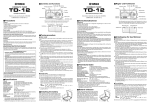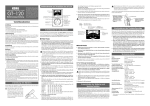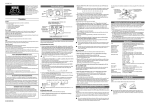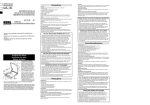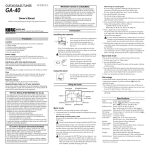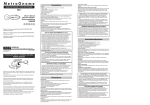Download Korg GA-30 Computer Monitor User Manual
Transcript
Precautions OWNER’S MANUAL MANUEL D’UTILISATION BEDIENUNGSANLEITUNG Thank you for purchasing the Korg GUITAR/BASS TUNER GA-30. Merci d’avoir fait l’acquisition du ACCORDEUR GUITARE ET BASSE GA-30 Korg. Herzlichen Dank für den Kauf des Korg GUITAR/BASS TUNER GA-30. KORG INC. 15-12, Shimotakaido 1-chome, Suginami-ku, Tokyo, Japan C 2001 KORG INC. Controls and functions Commandes et fonctions Regler und Funktionen Location Using the unit in the following locations can result in a malfunction. • In direct sunlight • Locations of extreme temperature or humidity • Excessively dusty or dirty locations • Locations of excessive vibration • Close to magnetic fields Power supply Be sure to turn the power switch to OFF when the unit is not in use. Remove the battery in order to prevent it from leaking when the unit is not in use for extended periods. Interference with other electrical devices Radios and televisions placed nearby may experience reception interference. Operate this unit at a suitable distance from radios and televisions. Handling To avoid breakage, do not apply excessive force to the switches or controls. Care If the exterior becomes dirty, wipe it with a clean, dry cloth. Do not use liquid cleaners such as benzene or thinner, or cleaning compounds or flammable polishes. Keep this manual After reading this manual, please keep it for later reference. Keeping foreign matter out of your equipment Never set any container with liquid in it near this equipment. If liquid gets into the equipment, it could cause a breakdown, fire, or electrical shock. Be careful not to let metal objects get into the equipment. CE mark for European Harmonized Standards CE mark which is attached to our company’s products of AC mains operated apparatus until December 31, 1996 means it conforms to EMC Directive (89/336/ EEC) and CE mark Directive (93/68/EEC). And, CE mark which is attached after January 1, 1997 means it conforms to EMC Directive (89/336/EEC), CE mark Directive (93/68/EEC) and Low Voltage Directive (73/23/EEC). Also, CE mark which is attached to our company’s products of Battery operated apparatus means it conforms to EMC Directive (89/336/EEC) and CE mark Directive (93/68/EEC). THE FCC REGULATION WARNING (for U.S.A.) This equipment has been tested and found to comply with the limits for a Class B digital device, pursuant to Part 15 of the FCC Rules. These limits are designed to provide reasonable protection against harmful interference in a residential installation. This equipment generates, uses, and can radiate radio frequency energy and, if not installed and used in accordance with the instructions, may cause harmful interference to radio communications. However, there is no guarantee that interference will not occur in a particular installation. If this equipment does cause harmful interference to radio or television reception, which can be determined by turning the equipment off and on, the user is encouraged to try to correct the interference by one or more of the following measures: • Reorient or relocate the receiving antenna. • Increase the separation between the equipment and receiver. • Connect the equipment into an outlet on a circuit different from that to which the receiver is connected. • Consult the dealer or an experienced radio/TV technician for help. Unauthorized changes or modification to this system can void the user’s authority to operate this equipment. IMPORTANT NOTICE TO CONSUMERS 1. Power switch / Interrupteur d ’alimentation / Netzschalter 2. INPUT jack / Prise INPUT / INPUT-Buchse 3. Display : a. Note name, b. Flat indicator, c. GUITAR/BASS indicator, d. Meter Affichage : a. nom de la note, b. indicateur bémol, c. indicateur GUITAR/BASS, d. aiguille Display : a. Notenname, b. Nullwertanzeige, c: Anzeige GUITAR/BASS, d: Meßskala 4. [GUITAR/BASS] switch / Sélecteur [GUITAR/BASS] / U m s c h a l t e r [GUITAR/BASS] 5. [FLAT] switch / Sélecteur bémol [FLAT] / [FLAT]-Taste 6. [SOUND] switch /Sélecteur de son [SOUND] / [SOUND]-Taste 7. Built-in mic / Micro incorporé / Eingebautes Mikrofon 8. Speaker / Haut-parleur / Lautsprecher 9. Tuning guide LEDs / Témoin du guide d’accordage / Abstimm-LEDs 10. Tilt slit The slit located on the back of the GA-30 is used to tilt the tuner. Place a card or similar object in the slit. (Do not use a valuable card.) Fente d’inclinaison La fente située à l’arrière du GA-30 est utilisée pour incliner le tuner. Insérez une carte ou un objet similaire dans la fente. (N’utilisez pas de carte de grande valeur). Neigeschlitz Der Schlitz an der Rückseite des GA-30 wird benutzt, um das Stimmgerät neigen zu können. Stecken Sie eine Karte oder ein ähnliches Objekt in den Schlitz. (Benutzen Sie keine wertvolle Karte.) This product has been manufactured according to strict specifications and voltage requirements that are applicable in the country in which it is intended that this product should be used. If you have purchased this product via the internet, through mail order, and/or via a telephone sale, you must verify that this product is intended to be used in the country in which you reside. WARNING: Use of this product in any country other than that for which it is intended could be dangerous and could invalidate the manufacturer's or distributor's warranty. Please also retain your receipt as proof of purchase otherwise your product may be disqualified from the manufacturer's or distributor's warranty. pas d'agents de nettoyage liquides tels que du benzène ou du diluant, voire des produits inflammables. Conservez ce manuel Après avoir lu ce manuel, veuillez le conserver soigneusement pour toute référence ultérieure. Evitez toute intrusion d'objets ou de liquide Ne placez jamais de récipient contenant du liquide près de l'instrument. Si le liquide se renverse ou coule, il risque de provoquer des dommages, un court-circuit ou une électrocution.Veillez à ne pas laisser tomber des objets métalliques dans le boîtier (trombones, par ex.). Marque CE pour les normes européennes harmonisées La marque CE apposée sur tous les produits de notre firme fonctionnant sur secteur jusqu'au 31 décembre 1996 signifie que ces appareils répondent à la Directive EMC (89/336/CEE) et à la Directive concernant la marque CE (93/68/ CEE). La marque CE apposée après le 1 janvier 1997 signifie que ces appareils sont conformes à la Directive EMC (89/336/CEE), à la Directive concernant la marque CE (93/68/CEE) ainsi qu'à la Directive Basse Tension (73/23/CEE). La marque CE apposée sur tous les produits de notre firme fonctionnant sur piles signifie que ces appareils répondent à la Directive EMC (89/336/CEE) et à la Directive concernant la marque CE (93/68/CEE). REMARQUE IMPORTANTE POUR LES CLIENTS Ce produit a été fabriqué suivant des spécifications sévères et des besoins en tension applicables dans le pays où ce produit doit être utilisé. Si vous avez acheté ce produit via l’internet, par vente par correspondance ou/et vente par téléphone, vous devez vérifier que ce produit est bien utilisable dans le pays où vous résidez. ATTENTION: L’utilisation de ce produit dans un pays autre que celui pour lequel il a été conçu peut être dangereuse et annulera la garantie du fabricant ou du distributeur. Conservez bien votre récépissé qui est la preuve de votre achat, faute de quoi votre produit ne risque de ne plus être couvert par la garantie du fabricant ou du distributeur. Vorsichtsmaßnahmen Aufstellungsort Vermeiden Sie das Aufstellen des Geräts an Orten, an denen • es direkter Sonneneinstrahlung ausgesetzt ist; • hohe Feuchtigkeit oder Extremtemperaturen auftreten können; • Staub oder Schmutz in großen Mengen vorhanden sind; • das Gerät Erschütterungen ausgesetzt sein kann. • in der Nähe eines Magnetfeldes. Stromversorgung Stellen Sie den Netzschalter auf OFF, wenn das Gerät nicht benutzt wird. Wenn Sie das Gerät über einen längeren Zeitraum nicht benutzen, nehmen Sie die Batterien heraus, damit sie nicht auslaufen. Störeinflüsse auf andere Elektrogeräte Dieser kann bei in der Nähe aufgestellten Rund-funkempfängern oder Fernsehgeräten Empfangsstörungen hervorrufen. Betreiben Sie solche Geräte nur in einem geeigneten Abstand von diesem Erzeugnis. Bedienung Vermeiden Sie bei der Bedienung von Schaltern und Reglern unangemessenen Kraftaufwand. Reinigung Bei auftretender Verschmutzung können Sie das Gehäuse mit einem trockenen, sauberen Tuch abwischen. Verwenden Sie keinerlei Flüssigreiniger wie beispielsweise Reinigungsbenzin, Verdünnungs- oder Spülmittel. Verwenden Sie niemals brennbare Reiniger. Bedienungsanleitung Bewahren Sie diese Bedienungsanleitung gut auf, falls Sie sie später noch einmal benötigen. Flüssigkeiten und Fremdkörper Stellen Sie niemals Behältnisse mit Flüssigkeiten in der Nähe des Geräts auf. Wenn Flüssigkeit in das Gerät gelangt, können Beschädigung des Geräts, Feuer oder ein elek-trischer Schlag die Folge sein. Beachten Sie, daß keinerlei Fremdkörper in das Gerät gelangen. Das CE-Zeichen für die Europäische Gemeinschaft Précautions Emplacement L'utilisation de cet instrument dans les endroits suivants peut en entraîner le mauvais fonctionnement. • En plein soleil • Endroits très chauds ou très humides • Endroits sales ou fort poussiéreux • Endroits soumis à de fortes vibrations • A proximité de champs magnétiques Alimentation Lorsque vous n’utilisez pas l’appareil, n’oubliez pas de le mettre hors tension. Retirez les piles pour éviter toute fuite lorsque l’appareil ne sera pas utilisé pendant de longues périodes de temps. Interférences avec d'autres appareils électriques Les postes de radio et de télévision situés à proximité peuvent par conséquent souffrir d'interférences à la réception. Veuillez dès lors faire fonctionner cet appareil à une distance raisonnable de postes de radio et de télévision. Maniement Pour éviter de les endommager, manipulez les commandes et les boutons de cet instrument avec soin. Entretien Lorsque l'instrument se salit, nettoyez-le avec un chiffon propre et sec. Ne vous servez Vor dem 31.12.1996 vergebene CE-Zeichen auf unseren netzgespeisten Geräten zeigen an, daß diese Geräte gemäß der EMC-Richtlinie (89/336/EWG) und der CERichtlinie (93/68/EWG) der EU arbeiten. Nach dem 01.01.1997 vergebene CE-Zeichen auf unseren netzgespeisten Geräten zeigen an, daß diese Geräte gemäß der EMC-Richtlinie (89/336/EWG), der CERichtlinie (93/68/EWG) und der Niederspannungsstromrichtlinie (73/23/EWG) der EU arbeiten. Die CE-Zeichen auf unseren batteriegespeisten Geräten zeigen an, daß diese Geräte gemäß der EMC-Richtlinie (89/336/EWG) und der CE-Richtlinie (93/68/ EWG) der EU arbeiten. WICHTIGER HINWEIS FÜR KUNDEN Dieses Produkt wurde unter strenger Beachtung von Spezifikationen und Spannungsanforderungen hergestellt, die im Bestimmungsland gelten. Wenn Sie dieses Produkt über das Internet, per Postversand und/oder mit telefonischer Bestellung gekauft haben, müssen Sie bestätigen, dass dieses Produkt für Ihr Wohngebiet ausgelegt ist. WARNUNG: Verwendung dieses Produkts in einem anderen Land als dem, für das es bestimmt ist, verwendet wird, kann gefährlich sein und die Garantie des Herstellers oder Importeurs hinfällig lassen werden. Bitte bewahren Sie diese Quittung als Kaufbeleg auf, da andernfalls das Produkt von der Garantie des Herstellers oder Importeurs ausgeschlossen werden kann. Tuning procedure Méthode d’accordage Arbeitsweise für das Stimmen ■ Meter mode ■ Mode indicateur (Meter) ■ Meter-Modus In this mode, the VU style meter shown in the display is used to tune your instrument. 1. If you are using an instrument with a pickup (such as an electric guitar) or a mic, connect the instrument or mic to the INPUT jack of the GA-30. If you wish to tune your instrument using the built-in mic, do not connect a plug to the INPUT jack. In steps 4 and 5, place your instrument as close as possible to the built-in mic. If a plug is connected to the INPUT jack, the built-in mic cannot be used. The INPUT jack is for mono use only. Stereo plugs cannot be used. 2. Press the power switch. When the power is on for 20 minutes without use, the tuner will automatically turn off to conserve battery life. 3. Press the [GUITAR/BASS] switch to select the instrument that you want to tune. Each setting allows the following tuning. GUITAR : 7B, 6E, 5A, 4D, 3G, 2B, 1E BASS : LB, 4E, 3A, 2D, 1G, HC (LB: Low B, HC: High C) 4. Play a single note on your instrument, and the name of the nearest note will appear in the display. Tune your instrument so that the correct note name is shown in the display. 5. Play a single note on your instrument, and tune it so that the meter needle points to the middle and the center indicator of the tuning guide is lit (if using A=440 Hz as the reference pitch). If your instrument is flat, the left indicator will light. If it is sharp, the right indicator will light. Each marking in the meter scale corresponds to 2 Hz. For example if you want to tune each string of your instrument using a reference pitch of A=436 Hz, adjust the tuning of each string so that the needle indicates two steps below «440». While tuning with the onboard mic a quiet environment is recommended for precise tuning. En mode Indicateur, l’indicateur de style VU affiché sur l’écran est utilisé pour accorder votre instrument. 1. Si vous utilisez un instrument avec un ampli (comme une guitare électrique) ou un micro, branchez le câble de l’instrument ou du micro à la prise INPUT du GA30. Si vous souhaitez accorder votre instrument en utilisant le micro incorporé, ne raccordez pas de fiche dans la prise INPUT. Aux étapes 4 et 5, placez votre instrument le plus près possible du micro incorporé. Si vous insérez une fiche dans la prise INPUT, vous ne pourrez plus utiliser le micro incorporé. Les deux prises sont des prises monaurales et elles ne peuvent pas être utilisées comme bornes stéréo. 2. Appuyez sur l’interrupteur marche/arrêt. Si vous n’utilisez pas l ’appareil pendant 20 minutes, il s’éteindra automatiquement afin d’économiser les piles. 3. Appuyez sur l’interrupteur [GUITAR/BASS] pour sélectionner l’instrument que vous désirez accorder. Chaque réglage permet l’accordage suivant. GUITARE : 7B, 6E, 5A, 4D, 3G, 2B, 1E BASSE : LB, 4E, 3A, 2D, 1G, HC (LB=Si bas, HC=Do haut) Remarque : A = La ; B = Si ; C = Do ; D = Rée ; E = Mi ; F = Fa ; G = Sol. 4. Jouez une seule note sur votre instrument et le nom de la note s’en rapprochant le plus apparaîtra sur l’écran. Accordez l’instrument de façon que le nom de note correct s’affiche. 5. Jouez une seule note sur votre instrument et accordez-le de façon que l’aiguille de l’indicateur vienne se placer au milieu et que l’indicateur central du guide d’accordage s’allume (si vous utilisez A = 440 Hz comme hauteur). Si votre instrument est trop bas, l’indicateur gauche s’allumera. S’il est trop haut, l’indicateur droit s’allumera. Chaque graduation de l’indicateur correspond à 2 Hz. Par exemple, si vous voulez accorder chaque corde de votre instrument en utilisant une hauteur de référence de A=436 Hz, vous devez régler l’accordage de chaque corde de telle sorte que l’aiguille indique deux graduations en dessous de «440». Il est recommandé d’accorder avec un micro intégré dans un environnement peu bruyant pour avoir un accordage précis. In diesem Modus wird die VU-Skala im Display benutzt, um Ihr Instrument zu stimmen. 1. Bei Verwendung eines Instrumentes mit Spulenelement (z.B. eine elektrische Gitarre) oder eines Mikrofons müssen Sie das Instrument oder Mikrofon an die INPUT-Buchse des GA-30 anschließen. Wenn Sie das interne Mikrofon zum Stimmen verwenden möchten, dürfen Sie nichts an der INPUT Buchse anschließen. Beim Ausführen der Schritte 4 und 5 müssen Sie das Instrument dann so nahe wie möglich an das interne Mikrofon halten. Solange ein Klinke an die INPUT- oder OUTPUT-Buchse angeschlossen ist, kann das interne Mikrofon nicht verwendet werden. Bedenken Sie außerdem, daß beide Klinkenbuchsen mono sind. Es können keine Stereo-Klinkenstecker angeschlossen werden. 2. Drücken Sie den Netzschalter. Wenn kein Signal eingespeist wird, schaltet sich das Gerät nach 20 Minuten aus. 3. Stellen Sie mit dem Umschalter [GUITAR/BASS] ein, welches Instrument Sie stimmen möchten. Die einzelnen Bezeichnungen erlauben das Stimmen folgender Noten. GUITAR : 7B, 6E, 5A, 4D, 3G, 2B, 1E BASS : LB, 4E, 3A, 2D, 1G, HC (LB: Tiefes H, HC: hohes C) 4. Spielen Sie jeweils Einzelnoten auf dem Instrument. Im Display erscheint der Name jener Note, die sich in unmittelbarer Nähe der erkannten Frequenz befindet. Stimmen Sie das Instrument so lange, bis der richtige Notenname im Display angezeigt wird. 5. Spielen Sie eine einzelne Note auf Ihrem Instrument, und stimmen Sie es so, daß die „Nadel“ der VU-Skala in der steht und die mittlere der Abstimm-LEDs leuchtet (wenn Sie A = 440 Hz als Referenzfrequenz benutzen). Die linke der AbstimmLEDs leuchtet, wenn der Ton zu tief gestimmt ist, und die rechte leuchtet, wenn der Ton zu hoch gestimmt ist. Jede Markierung in der Skala entspricht einer Verstimmung um 2 Hz. Wenn Sie z. B. jede Saite Ihres Instruments auf eine Referenztonhöhe von A = 436 Hz stimmen möchten, stimmen Sie jede Saite so, daß die Nadel zwei Striche unterhalb „440“ anzeigt. Beim Stimmen mit dem eingebauten Mikrofon ist für ein genaues Ergebnis eine ruhige Umgebung notwendig. ■ Mode Son (Sound) In diesem Modus können Sie Ihr Instrument nach einem Referenzton stimmen. ■ Sound mode In this mode you can tune while listening to a reference pitch. 1. Select the settings described in steps 2–3 of "Meter mode." 2. Press the [SOUND] switch to enter Sound mode. 3. Press the [SOUND] switch until the note to which you wish to tune appears in the display. For the notes that can be output, refer to step 3 of «Meter mode.» When you make a complete cycle, you will return to Meter mode. - GUITAR will output a pitch that is one octave higher than the actual pitch of your instrument, and BASS will output a pitch that is two octaves higher. 4. Listen to the pitch sounded by the GA-30, and tune your instrument accordingly. ● Flat tuning You can use Meter mode or Sound mode to tune to a pitch that is lowered by 1–5 semitones ( – ) for the specified note. 1. As described in "Meter mode" or "Sound mode," make the note you wish to flatten by 1–5 semitones appear in the display. 2. Press the [FLAT] switch to select the number of semitones that you wish to lower the selected note. The display will indicate – (1–5 semitones). (This setting is not remembered when you turn the power off.) 3. Tune your instrument. En mode Son, vous pouvez accorder en écoutant une hauteur de référence. 1. Effectuez les réglages décrits aux étapes 2-3 du Mode Indicateur. 2. Appuyez sur le sélecteur [SOUND] pour passer en Mode Son. 3. Appuyez sur le sélecteur [SOUND] jusqu’à ce que s’affiche la note sur laquelle vous désirez vous accorder. Pour les notes qui peuvent être jouées, reportez-vous à l’étape 3 du «Mode indicateur». Lorsque vous aurez effectué un cycle complet, vous retournerez en Mode indicateur. - GUITARE va émettre une hauteur qui est une octave plus haute que la hauteur réelle de votre instrument, et BASSE va émettre une hauteur qui est deux octaves plus hautes. 4. Ecoutez la hauteur de la note produite par le GA-30 et accordez l’instrument sur cette note. 1. Führen Sie die Schritte 2 und 3 des obigen Abschnitts „Meßmodus“ aus. 2. Drücken Sie die [SOUND]-Taste, um den Sound-Modus aufzurufen. 3. Drücken Sie die Taste [SOUND] und wählen Sie den Namen der Note, die Sie stimmen möchten. Für die auszugebenden Noten lesen Sie Schritt 3 unter „Meßmodus“. Wenn Sie einmal durch alle Noten geschaltet haben, gelangen Sie zurück in den Meßmodus. - Bei GUITAR liegt die zu hörende Tonhöhe eine Oktave höher als die tatsächliche Tonhöhe Ihres Instruments; in der Einstellung BASS liegt die zu hörende Tonhöhe zwei Oktaven höher. 4. Achten Sie auf die vom GA-30 ausgegebene Referenznote, während Sie Ihr Instrument stimmen. ● Accordage bémol Können Sie sowohl im Meter- als auch im Sound-Modus eine um 1 bis 5 Halbtöne nach unten versetzte Stimmung verwenden ( – ). 1. Sorgen Sie im Meter- bzw. Sound-Modus dafür, daß die um 1~5 Halbtöne zu versetzende Note im Display erscheint. 2. Drücken Sie die [FLAT]-Taste so oft, bis die gewünschte Anzahl der Halbtonschritte im Display erscheint. Dieser Versatz wird folgendermaßen angezeigt: – (1-5 Halbtöne tiefer). (Diese Einstellung bleibt nicht erhalten, wenn das Gerät ausgeschaltet wird.) 3. Stimmen Sie Ihr Instrument. Vous pouvez utiliser les modes Indicateur ou Son pour accorder l’instrument sur une hauteur diminuée de 1 à 5 demi-tons ( – ) pour la note donnée. 1. Comme pour les modes Indicateur ou Son, affichez la note dont vous souhaitez baisser la hauteur d’1 à 5 demi-tons. 2. Appuyez sur le sélecteur [FLAT] pour choisir le nombre de demi-tons souhaités pour baisser la hauteur de la note sélectionnée. L’écran indiquera – (1 à 5 demi-tons) (Ce réglage n’est pas mémorisé lorsque vous éteignez l’appareil). 3. Accordez l’instrument. Specifications Spécifications techniques : 12 note equal-tempered : B0 (23.12Hz)–B6 (1975.54Hz) : Guitar/Bass tone : [GUITAR] 7B➝6E➝5A➝4D➝3G➝2B➝1E [BASS] LB➝4E➝3A➝2D➝1G➝HC (Pitch is 1 octave higher for GUITAR, 2 octaves higher for BASS) Tuning modes : METER (AUTO GUITAR/BASS) SOUND (MANUAL GUITAR/BASS) Flat tuning function : 1–5 semitones (semitone steps) Detection accuracy : ±1 cent Sound accuracy : ±1.5 cent Connection jack : INPUT jack (1/4” mono) Power supply : two AAA batteries 3V Battery life : Approximately 100 hours (Conventional batteries, Meter mode, A4 continuous input) Dimensions : 4.1” (W) x 2.52” (D) x 0.6” (H) (104 mm x 64 mm x 15 mm) Weight : 2.86 oz (81g) : including the battery Included items : Owner’s Manual, two AAA batteries * Specifications and appearance are subject to change without notice for improvement. : 12 notes à tempérament égal : Si0 (23,12Hz)~Si6 (1975,54 Hz) : Signal de guitare/de basse : [GUITAR] 7B➝6E➝5A➝4D➝3G➝2B➝1E [BASS] LB➝4E➝3A➝2D➝1G➝HC (La hauteur est une octave plus élevée pour GUITARE et deux octaves plus élevée pour BASSE) Modes d’accord : METER (AUTO GUITARE/BASSE) SOUND (MANUEL GUITARE/BASSE) Fonction d’accord en bémol : 1~5 demi-tons (pas de demi-tons) Précision de détection : ±1 centième Précision du son : ±1,5 centième Prise jack : prise jack INPUT (entrée monaurale d’1/4’’) Alimentation : deux piles R3 3V Durée des piles : Environ 100 heures pour des piles conventionnelles (en mode Indicateur avec une entrée continue en A4) Dimensions : 104 mm (l) X 64 mm (P) X 15 mm (H) Poids : 81 g., piles comprises Accessoires fournis : Manuel d’instructions, deux piles R3 * Les spécifications et l’apparence peuvent changer sans préavis pour des raisons d’amélioration du produit. Installing the battery Installation des piles While pressing on the tabs marked PUSH on both sides, open the case, and insert the batteries being careful to observe the correct polarity. Battery life may differ according to the conditions of use. If the unit malfunctions, and turning the power OFF and then ON does not resolve the problem, remove and then reinstall the batteries. Tout en appuyant sur les deux côtés à l’endroit marqué PUSH (pousser), ouvrez le boîtier et introduisez les piles en faisant bien attention de respecter la polarité.Les piles s’useront plus ou moins vite selon les conditions d’utilisation. Si l’appareil ne fonctionne pas correctement, même après l’avoir éteint et rallumé une fois, retirez puis réintroduisez les piles. Tuning Detection range Reference tone ■ Sound-Modus Accord Portée de détection Son de référence ● "Flat"-Stimmung (Versatzstimmung) Technische Daten : 12 gleichschwebende Töne : B0 (23,12Hz)–B6 (1975,54 Hz) : Gitarren-/Bass-Signal : [GUITAR] 7B➝6E➝5A➝4D➝3G➝2B➝1E [BASS] LB➝4E➝3A➝2D➝1G➝HC (Die Tonhöhe ist 1 Oktave höher bei GUITAR, 2 Oktaven höher bei BASS.) Stimmodi : METER (AUTO GUITAR/BASS) SOUND (MANUAL GUITAR/BASS) Flat Tuning-Funktion : 1–5 Halbtöne (Halbtonschritte) Erkennungsgenauigkeit : ±1 Cent Referenzton-Genauigkeit : ±1,5 Cent Anschlußbuchse : INPUT-Buchse (1/4" mono) Stromversorgung : 2 Mikrozellen 3V Lebensdauer der Batterien : Lebensdauer der Batterien : Etwa 100 Stunden (herkömmliche Batterien, Meßmodus, kontinuierliche Eingabe der Note A4) Abmessungen : 104 mm (B) x 64 mm (T) x 15 mm (H) Gewicht : 81 g inklusive Batterien Beiliegendes Zubehör : Bedienungsanleitung, 2 Mikrozellen Stimmung Erkennungsbereich Referenznoten * Änderungen, die dem technischen Fortschritt dienen, können jederzeit ohne Ankündigung vorgenommen werden. Batterie einbauen Drücken Sie auf beiden Seiten auf den mit PUSH markierten Bereich, öffnen Sie das Gehäuse und legen Sie die Batterien ein.Achten Sie auf die korrekte Polarität. Abhängig von den Einsatzbedingungen des Geräts, kann die Lebensdauer der Batterien unterschiedlich lang sein. Falls Fehlfunktionen auftreten, die sich durch Aus- und Einschalten des Geräts nicht beheben lassen, nehmen Sie die Batterien heraus und bauen Sie sie nochmals ein.
This document in other languages
- français: Korg GA-30
- Deutsch: Korg GA-30





